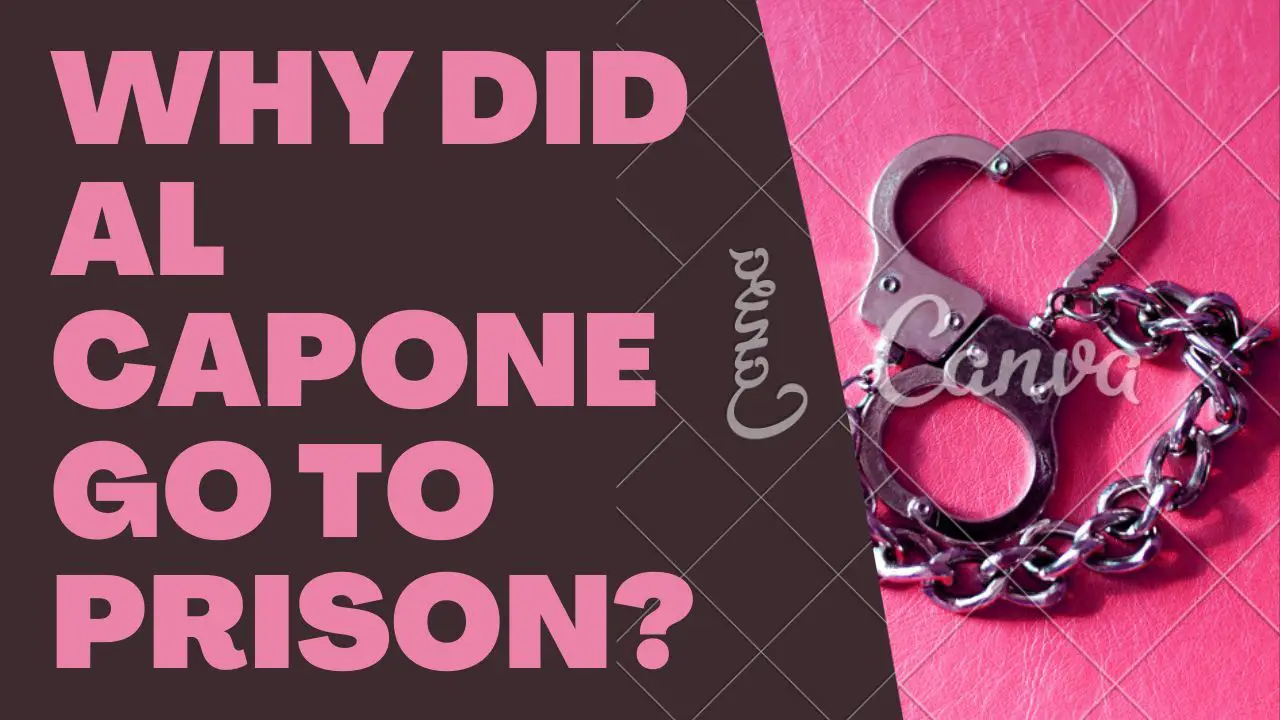Why did Al Capone Go to Prison?
Why did Al Capone Go to Prison? In this article, we have discussed everything you need to know about Al Capone.

Al Capone is one of the most infamous figures in American history who was known as a powerful mob boss in the early 20th century. With his ruthless tactics and involvement in organized crime, Capone became a symbol of lawlessness during the Prohibition era. Despite his notorious activities, Capone remains a fascinating and enduring figure in American popular culture. From movies and television shows to books and documentaries, his story continues to captivate audiences decades after his death.
This article will examine Al Capone's early criminal beginnings, rise to power, notorious actions, arrest and conviction, and lasting impact on American culture. This article will provide insight into one of the most renowned figures in American history and how his reputation continues to affect American culture today through a combination of historical analysis and popular portrayals of Capone.
Who is Al Capone?
Childhood and Family Background
Al Capone was born in New York on January 17, 1899. His parents were Italian Immigrants. His father was a barber and his mother was a seamstress. They lived in a poor neighborhood. Capone had eight siblings. He dropped out of school in the sixth grade to help support his family.
Early Life and Criminal Beginnings
Capone's first criminal offenses occurred while he was still a teenager. He joined a street gang called the Five Points Gang, which was involved in various illegal activities such as theft, extortion, and prostitution. Capone quickly gained a reputation as a tough and ruthless enforcer, and he was arrested several times for minor offenses such as vagrancy, disorderly conduct, and carrying a concealed weapon.
Moving to Chicago and Joining the Mob
In 1919, Capone moved to Chicago to work for his friend and mentor, Johnny Torrio, who was a top lieutenant in the Chicago Outfit, a powerful organized crime syndicate. Torrio recognized Capone's potential and put him in charge of several illegal enterprises, including prostitution, bootlegging, and gambling. Capone quickly established himself as a valuable asset to the Outfit, and he earned a reputation for his violent and ruthless tactics.
Al Capone’s Rise to Power
Prohibition and Bootlegging
Prohibition was the result of the 18th Amendment to the United States Constitution, which was ratified in 1919. The law made it illegal to manufacture, sell, or transport intoxicating beverages within the country, to reduce alcohol consumption and related social problems. However, the law had the opposite effect, and the demand for alcohol only increased. Many people turned to bootlegging, which was the illegal production and distribution of alcohol, as a way to satisfy their cravings. This created a lucrative market for those willing to take the risk.
Capone recognized the opportunity presented by the ban on alcohol, and he quickly became involved in bootlegging. He started as a low-level enforcer for the Chicago Outfit, a powerful criminal organization, but he quickly rose through the ranks. He worked his way up to become a top lieutenant, and then the leader of the organization.
Taking Control of Chicago’s Crime Scene
Multiple gangs and criminal organizations fought for control of the local underworld in Chicago, which was known for being a hub of criminal activity. The North Side Gang and South Side Gang each controlled a portion of the city in the early 1920s. But Capone was able to seize control of the city's criminal underworld. By using threats and violence, Al Capone got rid of his rivals. He also developed a network of dishonest police officers and politicians to stand up for his criminal enterprises. To increase his influence and power, he also formed partnerships with other criminal gangs, such as the Italian Mafia.
Becoming the Most Powerful Mob Boss
Capone's rise to power culminated in the late 1920s when he became the most powerful mob boss in Chicago. He controlled a vast criminal empire that included bootlegging, gambling, prostitution, and racketeering. Capone's wealth and power allowed him to live a lavish lifestyle, complete with a luxurious mansion, expensive cars, and a staff of loyal servants. He also had a reputation for being generous, often giving money to the poor and funding charities.
Al Capone’s Most Notorious Activities
St. Valentine’s Day Massacre
One of the most notorious crimes associated with Al Capone was the St. Valentine's Day Massacre, which took place on February 14, 1929. Seven members of the rival North Side Gang were gunned down in a garage on Chicago's North Side. The killers, who were dressed as police officers, used machine guns to execute their victims. The massacre was widely believed to have been ordered by Capone who was in Florida at the time. Although Capone was never officially charged with the crime, it damaged his reputation and increased pressure on law enforcement to bring him to justice.
The St. Valentine's Day Massacre was a turning point in the fight against organized crime in America. It shocked the public and forced law enforcement to take a more aggressive stance against gangsters like Capone. It also led to the creation of the Federal Bureau of Investigation (FBI), which was tasked with investigating and prosecuting organized crime.
Involvement in the Gambling Industry
Capone's criminal empire included a vast network of illegal gambling operations. He owned several casinos and betting parlors in Chicago and other cities, where people could bet on sports, card games, and other forms of gambling. Capone also had a reputation for fixing sporting events to ensure that his bets would win. He was known to have close ties to several professional athletes, including boxers and baseball players.
Read Why Did Robert Downey Jr. Go to Prison?
Gambling was a lucrative business for Capone and a key part of his criminal activities. It allowed him to launder money, bribe officials, and control other criminal operations. Capone's gambling empire was so vast that it was estimated to be worth millions of dollars a year.
Extortion and Bribery
One of Capone's primary methods of gaining control over businesses in Chicago was extortion. He would demand "protection money" from small business owners, threatening to burn down their shops or harm their families if they refused to pay. Capone's use of violence and intimidation allowed him to gain control over many legitimate businesses in Chicago, including restaurants, bars, and nightclubs.
Al Capone in Prison
Despite his power and influence, Al Capone was eventually caught by law enforcement and convicted of several crimes. The charges against him included tax evasion, contempt of court, and various other criminal offenses.
Tax Evasion Charges
Capone's downfall began when the federal government began investigating his finances in 1927. At the time, Capone was making millions of dollars a year from his various criminal enterprises, but he had never paid any income tax. The government launched an investigation into his finances, hoping to find evidence that would lead to his arrest and conviction.
During the trial, the prosecution presented evidence that showed that Capone had evaded paying his taxes for several years. They showed how he had hidden his income and assets through a complex system of shell companies and false tax returns. Capone's defense argued that he had paid tax for everything that he owned, but the jury was not convinced.
Trial and Sentencing
In 1931, Al Capone was brought to trial on charges of tax evasion. The trial was held in Chicago, and Capone was represented by a team of high-powered lawyers. However, the evidence against him was overwhelming, and he was found guilty on all counts.
Read Why are The Chrisleys Going to Prison?
Capone was sentenced to 11 years in prison and a $50,000 fine. The sentence was one of the longest ever handed down for tax evasion at the time. Capone was devastated by the verdict, and he reportedly wept in his cell after the sentencing.
Imprisonment at Alcatraz
Capone was sent to the U.S. Penitentiary in Atlanta, where he continued to try to run his criminal empire from behind bars. However, his power and influence were greatly diminished, and he was eventually transferred to Alcatraz, a high-security prison on an island off the coast of San Francisco.
At Alcatraz, Capone was subjected to harsh conditions and strict discipline. He was not allowed to have any contact with the outside world, and he was forced to wear a prison uniform at all times. Capone's health also began to decline, and he was eventually released from prison on medical parole in 1939.
Death of Al Capone
Al Capone died in 1947 at the age of 48, but the circumstances surrounding his death are still shrouded in mystery. Some sources claim that he died of a heart attack, while others suggest that he may have been poisoned or killed by one of his enemies. There are also rumors that Capone faked his death and disappeared into obscurity, but again, there is little evidence to support this theory.
In conclusion, while Al Capone's life and crimes have been well-documented, there are still many unanswered questions and controversies surrounding his legacy. From his ties to the mob and other criminals to his potential involvement in other crimes, there is still much that we don't know about this infamous figure.
Read more related articles.
